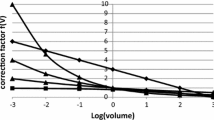Summary
A rapid mitogenic assay suitable for the detection of transforming growth factors in the extracts of tissues or cells or in the medium conditioned by tumor cells in vitro is described. The method utilizes a nontumorigenic mouse embryo cell line (AKR-2B cells) maintained in serum-free conditions. Three classes of growth factors can be distinguished using this assay.
Similar content being viewed by others
References
Abraham, R. T.; Swanson-Hsu, B. M.; Moses, H. L., et al. Regulation of gene expression and proliferation in mouse AKR-2B cells by polypeptide growth factors, phorbol esters and diacylglycerol. Submitted to J. Cell. Physiol. 1987.
Assoian, R. K.; Komoriya, A.; Meyers, C. A.: et al. Transforming growth factor-B in human platelets: Identification of a major storage site, purification and characterization. J. Biol. Chem. 258:7155–7160; 1983.
Coffey, R. J., Jr.; Shipley, G. D.; Moses, H. L. Production of transforming growth factors by human colon cancer lines. Cancer Res. 46:2068–2071; 1986.
Derynck, R.; Roberts, A. B.; Winkler, M. E., et al. Human transforming growth factor-alpha: Precursor structure and expression in E. coli. Cell 38:287–297; 1984.
Derynck, R.; Jarrett, J. A.; Chen, E. Y., et al. Human transforming growth factor-beta cDNA sequence and expression in tumor cell lines. Nature 316:701–705; 1985.
Goustin, A. S.; Leof, E. B.; Shipley, G. D.; et al. Growth factors and cancer. Cancer Res. 46:1015–1029; 1986.
Lobb, R. R.; Harper, J. W.; Fett, J. W. Purification of heparinbinding growth factors. Anal. Biochem. 154:1–14; 1986.
Marquardt, H.; Hunkapiller, M. W.; Hood, L. E., et al. Transforming growth factors produced by retrovirus-transformed rodent fibroblasts and human melanoma cells: Amino acid sequence homology with epidermal growth factor. Proc. Natl. Acad. Sci. USA 80:4684–4688; 1983.
Moses, H. L.; Branum, E. B.; Proper, J. A., et al. Transforming growth factor production by chemically transformed cells. Cancer Res. 41:2842–2848; 1981.
Moses, H. L.; Childs, C. B.; Halper, J., et al. Role of transforming growth factors in neoplastic transformation. In: Veneziale, C. M., ed., Control of cell growth and proliferation. New York: Van Nostrand Reinhold Co.; 1984:147–167.
Moses, H. L.; Tucker, R. F.; Leof, E. B., et al. Type beta transforming growth factor is a growth stimulator and a growth inhibitor. Cancer Cells 3:65–71; 1985.
Rizzino, A. Behavior of transforming growth factors in serum-free media: An improved assay for transforming growth factors. In Vitro 20:815–822; 1984.
Rizzino, A.; Ruff, E.; Rizzino, H. Induction and modulation of anchorage-independent growth by platelet-derived growth factor, fibroblast growth factor, and transforming growth factor-beta. Cancer Res. 46:2816–2820; 1986.
Roberts, A. B.; Lamb, L. C.; Newton, D. L., et al. Transforming growth factors: Isolation of polypeptides from virally and chemically transformed cells by acid/ethanol extraction. Proc. Natl. Acad. Sci. USA 77:3494–3498; 1980.
Roberts, A. B.; Anzano, M. A.; Wakefield, L. M., et al. Type B transforming growth factor: A bifunctional regular of cellular growth. Proc. Natl. Acad. Sci. USA 82:119–123; 1985.
Shipley, G. D.; Ham R. G. Improved medium and culture conditions for clonal growth with minimal serum protein and for enhanced serum-free survival of Swiss 3T3 cells. In Vitro 17:656–670; 1981.
Shipley, G. D.; Childs, C. B.: Volkenant, M. E., et al. Differential effects of epidermal growth factor, transforming growth factor, and insulin on DNA and protein synthesis and morphology in serum-free cultures of AKR-2B cells. Cancer Res. 44:710–716; 1984.
Shipley, G. D.; O'Sullivan, D.; Swanson, B. M., et al. Isolation of pituitary-derived fibroblast growth factor (FGF) by heparin agarose chromatography and its effect on gene expression in mouse AKR-2B cells. Fed. Proc. 44:626; 1985.
Shipley, G. D.; Tucker, R. F.; Moses, H. L. Type B-transforming growth factor/growth inhibitor stimulates entry of monolayer cultures of AKR-2B cells into S phase after a prolonged prereplicative interval. Proc. Natl. Acad. Sci. USA 82:4147–4151; 1985.
Shipley, G. D.; Pittelkow, M. R.; Wille, J. J., Jr., et al. Reversible inhibition of normal human prokeratinocyte proliferation by Type B transforming growth factors-growth inhibitor in serum-free medium. Cancer Res. 46:2068–2071; 1986.
Sparks, R. L.; Estervig, D. N.; Scott, R. E. Differentiation control and the suppression of carcinogenesis. In: Colburn, H. L.; Moses, H. L.; Stanbridge, E. J., eds. Growth factors, tumor promoters and cancer genes. New York: Alan R. Liss. Inc.; 1986: in press.
Sporn, M. B.; Todaro, G. J. Autoerine secretion and malignant transformation of cells. N. Engl. J. Med. 303: 878–880; 1980.
Sporn, M. B.; Roberts, A. B.; Wakefield, L. M., et al. Transforming growth factor-beta: Biological function and chemical structure. Science 223:532–534; 1986.
Todaro, G. J.; Fryling, C.; DeLarco, J. E. Transforming growth factors produced by certain human tumor cells: Polypeptides that interact with epidermal growth factor receptors. Proc. Natl. Acad. Sci. USA 77:5258–5262; 1980.
Tucker, R. F.; Shipley, G. D.; Moses, H. L., et al. Growth inhibitor from BSC-1 cells closely related to the platelet type beta transforming growth factor. Science 226:705–707; 1984.
Wille, J. J., Jr.; Pittelkow, M. R.; Shipley, G. D., et al. Integrated control of growth and differentiation of normal human prokeratinocytes cultured in serum-free medium: Clonal analysis, growth kineties, and cell cycle studies. J. Cell. Physiol. 121:31–44; 1984.
Author information
Authors and Affiliations
Rights and permissions
About this article
Cite this article
Shipley, G.D. A serum-free [3H]thymidine incorporation assay for the detection of transforming growth factors. Journal of Tissue Culture Methods 10, 117–123 (1986). https://doi.org/10.1007/BF01404602
Issue Date:
DOI: https://doi.org/10.1007/BF01404602




